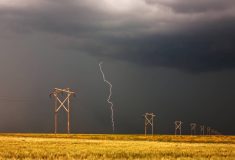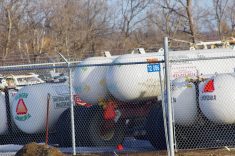In last December’s Grainews, I discussed interpretation of soil test reports. In this column, I will discuss developing nitrogen (N) recommendations. In the next several columns, I will discuss developing fertilizer recommendations for phosphorus (P), potassium (K), sulphur (S) and other nutrients.
Western Canadian farmers spend more money on nitrogen fertilizer than all other nutrients combined. Various soil and fertilizer nitrogen forms also have more potential loss mechanisms than any other plant nutrients. Therefore, developing nitrogen fertilizer recommendations for each field and crop deserves considerable thought and attention.
Read Also

Glufosinate-resistant waterhemp appears in U.S. Midwest
News of glufosinate-resistant kochia in the U.S. is concerning as farmers are losing options to control waterhemp, also of the pigweed family.
Agronomists and soil testing labs use various ways to develop nitrogen fertilizer recommendations. Ideally, the best way to estimate nitrogen fertilizer requirements is using regional nitrogen fertilizer response curves for the agroecological area you farm.
Nitrogen fertilizer response curves are developed from nitrogen fertilizer rate trials on typical soils in your region over a period of years with the newest crop varieties. Up-to-date nitrogen response curves take into account soil test nitrate-N, soil mineralization, nitrogen fertilizer efficiency, stored soil moisture and growing season precipitation. The benefit of this information is by using the cost of nitrogen fertilizer and the estimated value of your crop, you can do economic analysis to determine the optimum economic rate of nitrogen fertilizer.
However, maintaining and updating nitrogen response curves for various crops in all the soil regions across the Prairies simply is not done any more. Alberta farmers do have access to the Alberta Agriculture fertilizer recommendation program called Alberta Farm Fertilizer Information Recommendation Manager (AFFIRM). This program can be accessed and downloaded free of charge from the Alberta Agriculture website at www.alberta.ca/alberta-farm-fertilizer-information-and-recommendation-manager.aspx.
The program was developed with all available nitrogen fertilizer response curves for the various agroecological areas of Alberta. It was updated two years ago, just before all staff involved with field research and managing the program were laid off. It contains the last updated fertilizer calibration curves for a number of irrigated crops and dryland crops for most Alberta soil zones. The program allows the user to input cropping history, soil test results, estimated crop value and fertilizer costs to easily calculate economic nitrogen rates using different scenarios. In my opinion, this is the preferred method to economically determine optimum nitrogen fertilizer rates. Unfortunately, many western Canadian farmers do not have this type of information for the areas they farm.
The next choice is to use the calculation method to develop nitrogen recommendations for each field and crop to be grown. To undertake this, soil test nitrate-N must be determined, and then careful thought is needed for other nitrogen factors. The main sources of nitrogen for crops include the following:
- Soil test nitrate-N (NO3-N) must be determined by soil testing the zero- to six-, six- to 12- and 12- to 24-inch depths and then add up the amounts in pounds per acre for each depth.
- Nitrogen mineralization is the nitrogen released from soil organic matter during the growing season. The amount released depends on soil type, previous crops, soil organic matter level, and soil moisture and temperature conditions during the growing season. Table 1 shows approximate nitrogen mineralized from various soils based on soil organic matter levels. It is very important to note these numbers can deviate significantly, depending on soil environmental conditions from year to year. Mineralization in your own fields can be estimated by knowing your soil test nitrogen and leaving unfertilized nitrogen test strips in each field. By measuring yield in the test strips, an estimate of nitrogen mineralization can be calculated.
- Legume nitrogen contributions are another source. Significant nitrogen may be released the year following a pulse crop, which should be taken into consideration.
- Manure nitrogen contributions are another source. Significant nitrogen is released up to three years after livestock manure application, which should be considered.
Nitrogen fertilizer calculation method
How does the nitrogen fertilizer calculation method work? We will use a field in the dark brown soil zone that will be seeded to wheat as an example. Let’s assume the soil test shows 20 pounds of nitrogen per acre in the top 24 inches and a soil organic matter level of four per cent. A realistic target yield for spring wheat must be selected based on previous experience, estimated stored soil moisture going into spring and average growing season precipitation. In the past, average wheat yields have ranged between 40 to 70 bushels per acre of wheat.
Spring wheat typically needs about four to five inches of water for vegetative growth, and each additional inch of water will contribute five to 10, or more, bushels per acre of yield, depending on environmental conditions during the growing season.
In a hotter and drier than normal year, yield increase is about five bushels per acre per inch of water. In an average year, it should be about six to eight bushels per acre per inch of water and in a wetter than normal year it can be up to eight to 10 bushels per acre per inch of water, or higher. Under optimum pivot irrigation, yield increase can be in the range of 10 bushels per acre or more per inch of water.
For this example, on a dryland farm in an average year, about four inches of water is needed for vegetative growth, with each additional inch of water increasing yield by six to seven bushels per acre. Let’s say there are four inches of stored soil moisture going into spring and the average growing season precipitation is about eight inches, then the stored soil moisture will look after vegetative growth and the eight inches of precipitation will go to yield. Use the assumption that spring wheat would produce about seven bushels per acre per inch of water, so eight inches of water times seven bushels per acre per inch equals 56 bushels per acre for a target yield. Therefore, use a target yield in the range of about 55 bushels per acre.
Next, multiply the target yield by the amount of nitrogen needed to produce a bushel of spring wheat. This value can vary considerably, ranging from about 1.7 to 2.5 pounds of nitrogen per bushel. Typically, when yield is lower, protein level is higher, and more nitrogen is used per bushel. Conversely, when moisture conditions are very good and yield is higher, protein tends to be a bit lower, and less nitrogen is used per bushel. For an average target yield in the range of 55 bushels per acre, multiply 55 bushels per acre by 2.0 pounds of nitrogen per bushel, which equals 110 pounds of nitrogen per acre.
Assuming soil test nitrogen is 20 pounds per acre, a very simple calculation to determine nitrogen fertilizer is subtract the total crop nitrogen requirement of 110 pounds of nitrogen per acre from the soil test nitrogen level of 20 pounds of nitrogen per acre, which is 90 pounds per acre of nitrogen fertilizer. This is a very simplistic way to determine nitrogen fertilizer level. However, I prefer to consider potential nitrogen mineralization and nitrogen fertilizer use efficiency in the determination.

My preferred example is the following — soil test nitrogen is 20 pounds per acre and soil nitrogen mineralization from the organic matter would be about 35 pounds per acre (see Table 1 above). From the total crop nitrogen required, subtract the soil test nitrogen and estimated nitrogen mineralization. In this example, it’s 110 pounds of nitrogen per acre minus 20 pounds per acre of soil nitrogen minus 35 pounds per acre of mineralized nitrogen, which equals 55 pounds of nitrogen per acre. Keep in mind that if the previous crop was a legume or if manure was applied to the field these nitrogen contributions must also be included in the calculation.
The estimated nitrogen fertilizer required is about 55 pounds per acre. However, soil and fertilizer nitrogen are not taken up with 100 per cent efficiency. Hopefully, fertilizer nitrogen is taken up at about 70 per cent efficiency if nitrogen is side- or mid-row banded at seeding. There will be some nitrogen tied up by soil microbes, and some potential nitrogen losses. Therefore, using an efficiency factor of 70 per cent to determine the applied fertilizer, 55 pounds of nitrogen per acre required divided by 0.7 equals 79 pounds of nitrogen per acre of fertilizer is required.
Using this relatively simple calculation method, about 75 to 80 pounds per acre of nitrogen fertilizer is required. This is a calculated estimate and does not take into account the value of spring wheat or the cost of the nitrogen fertilizer.
The big unknown every year is the environmental conditions that will occur during the growing season, after most or all of the nitrogen fertilizer is applied. We don’t know ahead of time if we will have a wetter, drier or near normal year. Therefore, I suggest being cautiously optimistic and fertilize for a reasonably good target yield each year.
















